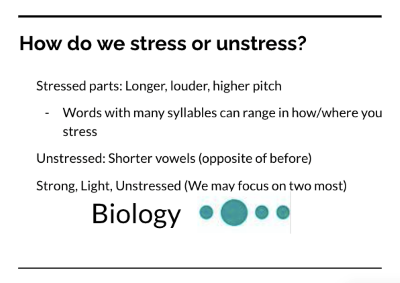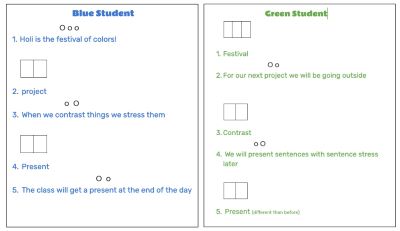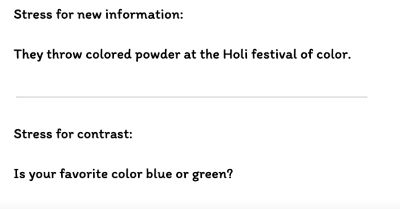|

Sydney Coloff
|
|

Myriam Carrillo
|
|

Ava Deitrich
|
Using correct stress in both words and in sentences is essential to being intelligible in English (Field, 2005; Hahn, 2004). Second language learners tend to be less intelligible when they stress the wrong syllable in a word and when they emphasize the wrong word in a sentence (Caspers, 2010; Hahn, 2004). Therefore, word and sentence stress are very important for learners not only to process spoken language in interaction, but also to increase their own intelligibility. This unit plan is designed to teach ESL learners both word and sentence stress, and it combines pronunciation instruction and cultural aspects that we might find in an imagined classroom community in an ESL context. The unit is intended to be adapted to fit the specific cultural identities of different classrooms. Hammond (2014), proclaims about the benefits of culturally responsive teaching, explaining that equally representing all students’ cultural backgrounds can improve performance and engagement (p. 3). Including cultural topics in the ESL classroom is essential for involving all of our students in lessons and allowing them to feel seen and recognized. Additionally, this unit follows the communicative framework for teaching pronunciation proposed by Celce-Murcia et al. (2010) that includes description and analysis, listening discrimination, controlled practice, guided practice, and communicative practice—each stage carried out on one day. All of the various steps of the communicative framework can be seen within and throughout our unit, in combination with a variety of different theories, activities, and other aspects. This unit is intended for a late middle school ESL classroom of approximately 20 B2 upper intermediate learners.
Unit Plan
Day 1: Description and Analysis
The first day’s lesson is the only day that is not based upon a cultural holiday, which is done to ensure that students can fully focus on learning the suprasegmentals we are teaching. To introduce lexical stress, we use the visual representation of “stress bubbles” and go over the patterns the English language follows for different aspects of lexical stress. In this way, students can begin to notice stress and develop awareness of it and why it is essential for intelligibility in spoken language (Schmidt, 2001) (see Figure 1). Though we cannot control exactly what students become fully aware of, providing them with that explicit material from the beginning can help them notice it more in the following activities of the week.
Figure 1
An example of a lecture slide using “stress bubbles” and information about how to use lexical stress (Celce-Murcia et al., 2010).

Discovery learning can help students think more deeply about what they see and hear. For this reason, in addition to the explicit explanation about word stress, using the example shown above, we also use an inductive approach to introduce sentence stress with a video of President Obama’s speeches being turned into the song, “Call Me Maybe” (Baracksdubs, 2012). Students are to attempt to pick out why they think it sounds “off” even though the words are pulled from a sentence in which they sound correct. This element may start off as more of a listening discrimination activity (2nd stage), so we recommend a descriptive explanation to come afterward to allow students to be fully aware of the ways sentence stress changes how sentences sound and what those changes mean beyond just hearing it.
Day 2: Listening Discrimination
On day two, the content focus is on a Día de los Muertos (Day of the Dead) themed video and music while using the second stage of the communicative framework (listening discrimination). For teaching word stress, we propose using multi-sensory reinforcement techniques. The students draw big and small stress bubbles over the stressed syllables in vocabulary words given in a handout after listening to them in the video. Then the students listen to the teacher clap a stress pattern and decide which vocabulary word matches that pattern; this is to use both auditory and kinetic processes to improve understanding. The vocabulary can be changed depending on the video chosen to be shown. According to Celce-Murcia et al. (2010), activities that appeal to different senses can improve pronunciation even after it has become fossilized (p. 337). Those visual and auditory examples can assist especially when authentic material is in use, which can also provide varied accents that can represent more than just one way of speaking depending on the video chosen.
The use of songs to teach English, and more specifically prominence, is shown to be effective, especially if teachers pick songs that the students know and can sing along with (Celce-Murcia et al., 2010, p. 353). Many students in class may be familiar with animated movies or musicals. One may be able to find a movie that fits whatever cultural holiday the content is based on. The aspect of an animated “sing-along” music video may interest them especially if they are familiar with the movie and it can provide another medium to hear that prominence and lexical stress in use.
Day 3: Controlled Practice
On day three, our controlled practice activities focus on both hearing and identifying stress in context with content relating to the holiday Holi, the festival of color. This repetitive practice does not have a lot of production, but it does help students begin to use the content in parts to transition to an automatic process later on. To practice word stress, students work in pairs on an information gap activity (see Figure 2). Students read specific content words (about Holi) in the context of a sentence; one reads while the other guesses where the stress falls in the word from hearing it. Every other question has the answer key “stress bubbles” in the key word, while the other question has boxes to fill in with the correctly sized “stress bubbles.”
Figure 2
Information gap activity example.

In the second activity, we connect sentence stress to Holi with a fun kinetic activity. In groups, students are given a sentence and a function of sentence stress (emphasis, new information, stress). The groups decide which part of the sentence to stress and share why, and we work through any problems as a class (see Figure 3). Afterward, we all go outside and each group yells out their sentences and throws colored Holi powder on the stressed word. The sentence stress activity does require some slight “guided practice” aspects since students are expected to define their rationale for their sentence stress, which is more open ended.
Figure 3
Example of sentences that can be used for this prominence activity.

Day 4: Guided Practice
On day four, centered around Lunar New Year, we showcase guided practice through the use of a role-play scenario, which allows students to practice using sentence and lexical stress while also creating their own authentic materials. Students are given information about Chinese Zodiacs and what they mean to provide context before the activity. In pairs, students ask each other questions from a (semi) prewritten script, focusing on the introduction of new information and how that affects sentence stress (see Figure 4).
Figure 4
Example of script worksheet inspired by the Lunar New Year.

In the second part, students are to come up with their own questions to probe for new information using vocabulary terms learned in class at the beginning of this lesson. In pairs, students ask and answer each others’ questions, write down the responses and create a “script” and present it at the end of class. At the end of day 4 as homework, students return home and ask a parent/guardian how to make a family recipe or research a recipe online, write it down, and bring it back in preparation for day five, when we compile all the recipes into a class cookbook.
Day 5: Communicative Practice
Day five is focused on Ramadan and more specifically Iftar, the meal that breaks the fast at sundown during Ramadan. This fifth day is also the day to implement communicative practice, the final stage of the framework. The central activity for the day is a jigsaw technique, a type of information gap activity. Groups of students are given different segments of the same recipe and they have to communicate amongst themselves in order to put the recipe together in order. According to Brown and Lee (2015), information-gap activities focus on meaning over form and prioritize communication by providing a common objective (p. 279). In this unit plan we use a maqluba recipe, but the recipe can be changed depending on students’ cultures or preferences. After the students assemble the recipe, we prepare the dish as a class.
Conclusion
This unit plan shows the importance of teaching word and sentence stress in a way students in an ESL context can identify with. The amount of support provided for differing levels of students can be adjusted accordingly. The communicative framework (Celce-Murcia et al., 2010) builds up students’ knowledge and encourages the transfer of skills from more controlled to communicative environments. This unit plan’s content is meant to be modified based on the cultures in any given classroom. Incorporating students’ own cultures into the framework allows students not only to find more connections in what they learn but creates a classroom environment that is centered around the learners themselves. By creating this environment with our students, we hope that they find their own intrinsic motivation to interact with the curriculum.
References
Caspers, J. (2010). The influence of erroneous stress position and segmental errors on intelligibility, comprehensibility, and foreign accent in Dutch as a second language. Linguistics in the Netherlands, 27(1), 17-29.
Baracksdubs. (2012, June 4). Barack Obama singing call me maybe by Carly Rae Jepson [Video]. Youtube. https://www.youtube.com/watch?v=hX1YVzdnpEc
Brown, H.D., & Lee, H. (2015). Teaching by principles: An interactive approach to language pedagogy (4th ed.). Pearson Education, Inc..
Celce-Murcia, M, Brinton, D. M., & Goodwin, J. M. (2010). Teaching pronunciation: A course book and reference guide (2nd edition). Cambridge University Press.
Field, J. (2005). Intelligibility and the listener: The role of lexical stress. TESOL Quarterly, 39(3), 399-423.
Hahn, L. (2004). Primary stress and intelligibility: Research to motivate the teaching of suprasegmentals. TESOL Quarterly, 38(2), 201-223.
Hammond, Z. (2014). Culturally responsive teaching and the brain: Promoting authentic engagement and rigor among culturally and linguistically diverse students. Corwin.
Schmidt, R. (2001). Attention. In P. Robinson (Ed), Cognition and second language instruction (pp. 3-32). Cambridge University Press.
Sydney Coloff graduates from the University of Northern Iowa in 2022 with BAs in Teaching English to Speakers of Other Languages (TESOL) and Spanish and a minor in Spanish-English Translation.
Myriam Carrillo, a student teacher from the University of Northern Iowa, is planning to graduate with a BA in TESOL and an endorsement to teach secondary mathematics in 2022.
Ava Deitrich is graduating from the University of Northern Iowa in 2023 with BAs in TESOL and English. She is continuing at UNI with a Masters in Student Affairs in Fall 2023. | 
